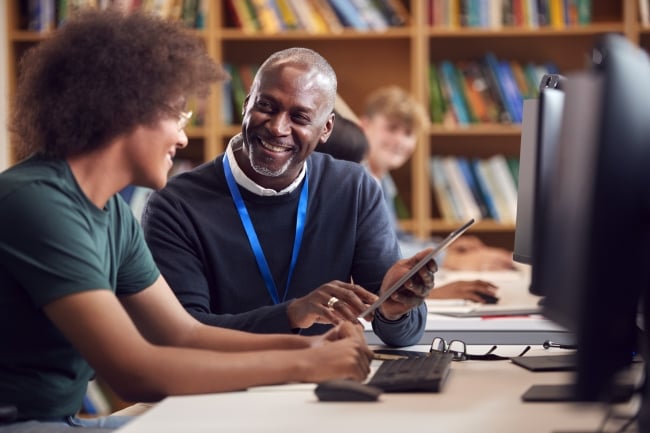You have /5 articles left.
Sign up for a free account or log in.

Librarians can participate in larger student success initiatives at a college or university through partnerships, collaborations or emphasis of what the library does well.
monkeybusinessimages/iStock/Getty Images
Libraries are more than just spaces to store books and archives on college campuses. They are also centers of learning and engagement for students and an important piece of holistic student success.
In recent years, libraries have evolved to become success hubs with social and service spaces and with more synergies between librarians and others across campus to share their expertise, explained Brett Bruner, assistant vice president for student success and persistence at Wichita State University, in a session at NASPA’s Conferences for Student Success in Higher Education in June.
Library staff can also help support institutional goals for student success by connecting learners to resources, hosting and collaborating with campus partners to hold events, designating space for student supports, and more, shared Kimberlie Moock, coordinator for the Toaster Innovation Hub at the University of Minnesota–Twin Cities, in the same conference session.
Here are four examples of interventions libraries have hosted and partnered in to engage and encourage students in their academic and personal journeys.
The Value of the Library
Libraries can provide four key elements to student success, Bruner and Moock shared:
- People, providing library staff as experts and housed within colleges, classes, programs and workshops.
- Place, as an area to serve unique population needs, demystify resources and help learners find community.
- Space, leveraging physical spaces to create engagement and communicate belonging.
- Resources, both literally in library archives and stacks, but also in the variety of human capital and high-impact learning practices available.
- Dedicating space to student engagement. One of the more popular strategies in student success work in the library has been remodeling space on campus to accommodate learner needs. Library usage trends have moved away from students looking for physical resources, such as books or desktop computers, and toward flexible areas that allow for gathering and learning.
The University of Hawai‘i at Mānoa converted a library on campus into a Student Success Center, creating new and improved study spaces, social gathering areas and charging facilities for students’ devices.
Libraries can also dedicate space for students with unique needs who may have limited physical resources on campus—commuter students often visit the library more often than their residential peers because they don’t have a private space on campus to turn to. Dedicated 24-7 spaces or commuter-friendly resources such as lockers, microwaves and charging stations can encourage commuters to stay on campus and connect with personnel.
At Boise State University in Idaho, parenting students can visit the family study room in Albertsons Library with their young children, designed to accommodate those under the age of 12 with computers, toys, books and more. This helps students feel more included and gives them a safe place to bring their children while they work.
- Promoting affordable resources. Personal finances are one of the top reasons a student might leave college, and libraries can contribute to learners’ financial wellness and retention by promoting affordable course material options.
At Gettysburg College, librarians created a student survey to highlight the high prices students paid for textbooks and led workshops to encourage professors to select free open educational resources. The initiative saved students over $300,000 in fall 2023 alone, with a total all-time savings of $1.6 million.
- Partnering with campus orgs. Student success initiatives don’t have to be led or directed by the library staff but could also happen in partnership with other stakeholders at the institution.
At Wichita State, staff moved their annual Long Night Against Procrastination event from the student center to the library, allowing students to connect with experts when they needed academic support. Librarians also brought their own special flair to the event, hosting a walking tour at sunset to encourage mindfulness and wearing matching pajamas.
The University of Arizona typically hires peer mentors to provide research and writing support to students. In partnership with the athletics department, UA embedded some of these student employees within sports facilities. The initiative helped make athletes more familiar with library resources and improved their academic skills.
- Supporting mental health. Libraries are typically known for housing academic resources, but they can also support students’ health and wellness.
Bryant University’s librarians noticed there was an uptick in mental health concerns among students using the library chat bot. Staff then partnered with the counseling center to get training for library employees to ensure they could have supportive and helpful conversations around mental health with visitors, Karen Greco, associate director of public relations, told Inside Higher Ed.
Library resources can also be used to educate and support students. Penn State University’s Berks Thun Library worked with university counseling staff to build a Wellness Collection inside the library that highlights 300 titles related to neurodivergence, communication skills, career development, mental health, surviving in college and more.
Wellness resources can also be located in the library. Low-sensory rooms have grown in popularity on campuses, both to accommodate those with learning or other disabilities and to help with anxiety and stress.
Do you have an academic success tip that might help others encourage student success? Tell us about it.




